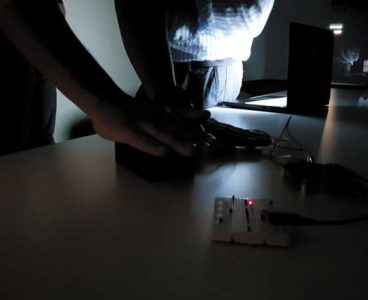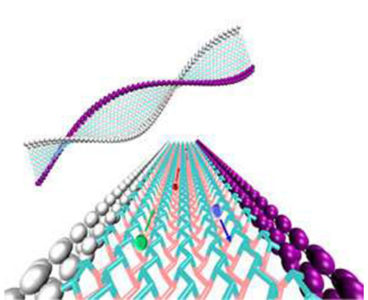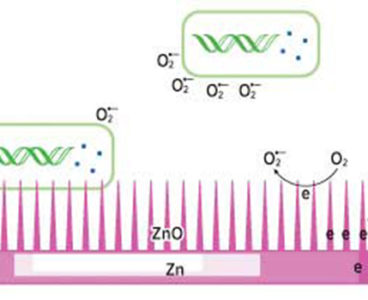Commercially-available diamond tips used in atomic force microscopy (AFM) could help make quantum nanoscale sensing cost-effective and practical, A*STAR researchers have found. The idea of using ‘color centers’, optically-active atomic defects in diamond, as a probe for taking highly sensitive nanoscale measurements of quantities such as elecromagnetic field, temperature, or strain is well known. In…
Nanoparticle Defects Drive Hydrogen Production
When hydrogen burns, it produces only water as a by-product, making it an attractive clean fuel for vehicles and other energy applications. However, most of the world’s hydrogen is currently produced using fossil fuels in a process that emits large amounts of the greenhouse gas carbon dioxide. Researchers are thus looking at making hydrogen by…
Body Heat Powers Electronic Devices
If thermoelectric materials can convert low-grade heat into electricity, we may never need to charge wearable technology at home again. At night, most of us plug in a jumble of wires and devices as we charge our smart watches, phones and fitness trackers. It’s a pile that’s unlikely to get any smaller as more and…
Nanoribbon Tweaks Drastically Alter Heat Conduction
Black phosphorene, an unusual two-dimensional (2-D) compound, may offer strategies for avoiding damaging hot spots in nanoscale circuits, a new study from A*STAR researchers has revealed. While carbon atoms in graphene films sit perfectly flat on a surface, black phosphorene has a distinct wrinkled shape due to the bonding preferences of its phosphorus atoms. Investigations…
Layered Chambers Open the Drug Release Window
Implantable arrays of microchambers show potential capacity for holding and releasing precisely controlled quantities of drugs on command, report A*STAR researchers with colleagues in Singapore, Russia, and the United Kingdom. A near-infrared laser beam acts to break open selected microchambers at the required time. “This near-infrared light is the perfect way to trigger drug release…
Inexpensive Technique Examines Samples at Infrared Wavelengths
A cheap, compact technique for analyzing samples at infrared wavelengths using visible-wavelength components could revolutionize medical and material testing. Infrared spectroscopy is used for material analysis, in forensics and in the identification of historical artifacts, for example — but scanners are bulky and expensive. Visible-wavelength technology is cheap and accessible in items such as smartphone…
Nanostructured Coatings Annihilate Bacteria
Coatings developed at A*STAR could soon replace biochemically active antibacterial agents, whose overuse in healthcare and fields such as agriculture and wastewater treatment is the main contributor to the growing global problem of antimicrobial resistance (Small, “ZnO nanopillar coated surfaces with substrate-dependent superbactericidal property”). Most antimicrobial strategies rely on applying small, polymer-based organic disinfectants or…
Innovative Laser is a Game-changer for Optoelectronics
A tiny laser comprising an array of nanoscale semiconductor cylinders has been made by an all-A*STAR team. This is the first time that lasing has been achieved in non-metallic nanostructures, and it promises to lead to miniature lasers usable in a wide range of optoelectronic devices. Microscale lasers are widely used in devices such as…
Semiconductor Lasers Shrunk to the Nanoscale
A tiny laser comprising an array of nanoscale semiconductor cylinders has been made by an all-A*STAR team (Nature Nanotechnology, “Directional lasing in resonant semiconductor nanoantenna arrays”). This is the first time that lasing has been achieved in non-metallic nanostructures, and it promises to lead to miniature lasers usable in a wide range of optoelectronic devices.…
Realizing Phosphorene’s Full Potential
A technique for investigating the wetting behavior of water on phosphorene — the single layer form of black phosphorus — has been developed by A*STAR researchers seeking to better understand properties that could enable its commercial applications (Journal of Physical Chemistry C, “Anisotropic wetting characteristics of water droplets on phosphorene: Roles of layer and defect…
Graphene Oxide Makes Batteries Cleaner, Cheaper
Incorporating organic materials into lithium ion batteries could lower their cost and make them more environmentally friendly, A*STAR researchers have found. The team has developed an organic-based battery cathode that has significantly improved electrochemical performance compared to previous organic cathode materials. Crucially, the new material is also robust, remaining stable over thousands of battery charge/discharge…
Nanowire Growth Controlled by Ligands
Adjustments to sulfur-containing molecules have enabled researchers to precisely control the growth of gold nanowires, which are potentially useful in various applications including biosensors and catalysis (Small, “Effect of thiolated ligands in Au nanowire synthesis”). Ligand molecules are used to prevent nanostructures from growing too large, or forming unwanted shapes. Suzhu Yu of the A*STAR…
Bacteria-Killing Nano Coating Mimics Dragonfly Wings
Studies have shown that the wings of dragonflies and cicadas prevent bacterial growth due to their natural structure. The surfaces of their wings are covered in nanopillars making them look like a bed of nails. When bacteria come into contact with these surfaces, their cell membranes get ripped apart immediately and they are killed. This…
Cancer Treatment Aided by Green Tea Nanocarriers
The Institute of Bioengineering and Nanotechnology (IBN) of A*STAR has reported superior results using new green tea-based nanocarriers to kill liver cancer cells, compared to existing drug delivery systems. IBN Team Leader and Principal Research Scientist, Dr. Motoichi Kurisawa, and his group recently published their findings in the scientific journal Advanced Materials. Researchers working on…
Flower-Shaped Gold Nanocrystals Fight Tumors
Gold nanoflowers grown in starfruit juice are promising agents for photothermal cancer therapy. When injected into a tumor and irradiated with near-infrared laser light, the nanoflowers heat up and kill the cancer cells around them. Although photothermal therapy is an established idea, the agents developed so far have had drawbacks, explains Enyi Ye from the…
Nano-Dagger Takes a Stab at Microbes
A powerful solution to the global spread of antimicrobial resistance could soon become available, thanks to A*STAR researchers, who have come up with a physical and green alternative to biochemically active antibacterial agents. Typically transmitted by contact with contaminated surfaces, bacterial infections pose serious health threats in medical settings. Small molecular antibacterial agents, which are…
Semiconductor Lasers Surpass Conventional Silicon-Based Systems
A systematic study of a simple and general structure for on-chip semiconductor lasers by A*STAR researchers sets the scene for much broader application of integrated semiconductor lasers beyond conventional silicon-based systems (Applied Optics, “Comparison of III-V/Si on-chip lasers with etched facet reflectors”). The ability to use, manipulate and sense light is applicable to many technologies,…
Nanostructures Created from Pioneering Wet Etching Method
Metal-assisted chemical etching, or “MacEtch,” is used to fabricate a range of nanostructures, but damaging movements of the catalyst during vertical etching processes hamper its wider use. Now, a team led by A*STAR have developed a technique that improves catalyst stability, paving the way for wider application. MacEtch is a wet etching method for fabricating…
For 2D Materials, Less is More
Molybdenum trioxide (MoO3) has potential as an important two-dimensional (2D) material, but its bulk manufacture has lagged behind that of others in its class. Now, researchers at A*STAR have developed a simple method for mass producing ultrathin, high-quality MoO3 nanosheets. Following the discovery of graphene, other 2D materials such as transition metal di-chalcogenides, began to…
New Letters Created in DNA Alphabet
Just like how letters are strung together to form words, our DNA is also strung together by letters to encode proteins. The genetic alphabet contains only 4 natural letters — A, C, G, and T, which hold the blueprint for the production of proteins that make our bodies work. Now, researchers from the Institute of…
Tiny Trenches Hold Secret to Ultrathin Sensors
Future ultrathin solar cells and light sources could have their surfaces covered by tiny trenches, after A*STAR researchers found such structures enhance efficiency by four orders of magnitude. Joel Yang from the A*STAR Institute of Materials Research and Engineering was part of an international collaboration that achieved a 20,000-fold increase in the photoluminescence of a…
Sticky Sensor Spares Patients from Painful IV Drops
A new adhesive sensor can save patients the discomfort and pain resulting from leaky intravenous drips. A significant number of hospitalized patients require the insertion of a thin tube, called a cannula, into a vein, usually in their hand or arm, to facilitate easy and sometimes lengthy delivery of drugs. If the vein is small…
Supercritical CO2 Adds Protective Skin to Semiconductor Surfaces
Silicon forms an oxide layer on its surface when exposed to air or moisture, which can detract from its electronic properties. Adding a “skin”’ of molecules to the silicon can provide a physical barrier that prevents oxidation, but forming these monolayers can be tricky, requiring an inert atmosphere and long processing times, or demand the…
Metal Sulfide Nanoparticles Controlled with Heat Treatment
Nanoparticle catalysts developed by A*STAR researchers can help split water to produce hydrogen, a clean-burning fuel that provides a convenient way to store renewable energy. Platinum is currently the most efficient catalytic electrode material for generating hydrogen in this way, but the precious metal is both scarce and expensive. Yee-Fun Lim and colleagues at the…
Stem Cells Used to Test Drug Side Effects
Different people react differently to the same drug, yet it is difficult to predict the side effects for an individual in advance. Now, researchers from the Institute of Bioengineering and Nanotechnology (IBN) of A*STAR and the National Cancer Centre Singapore (NCCS) have demonstrated a promising approach to screen for severe side effects by first testing…



















